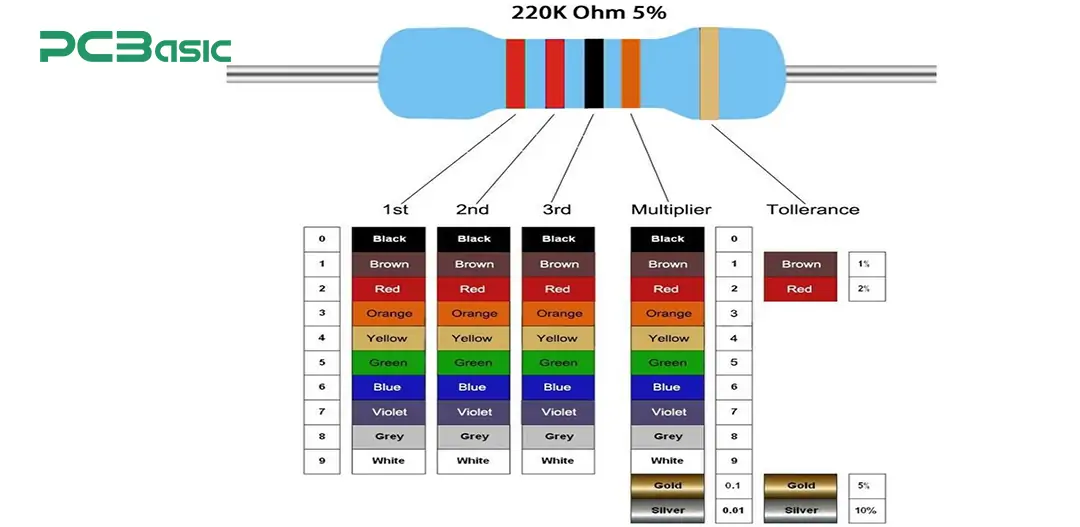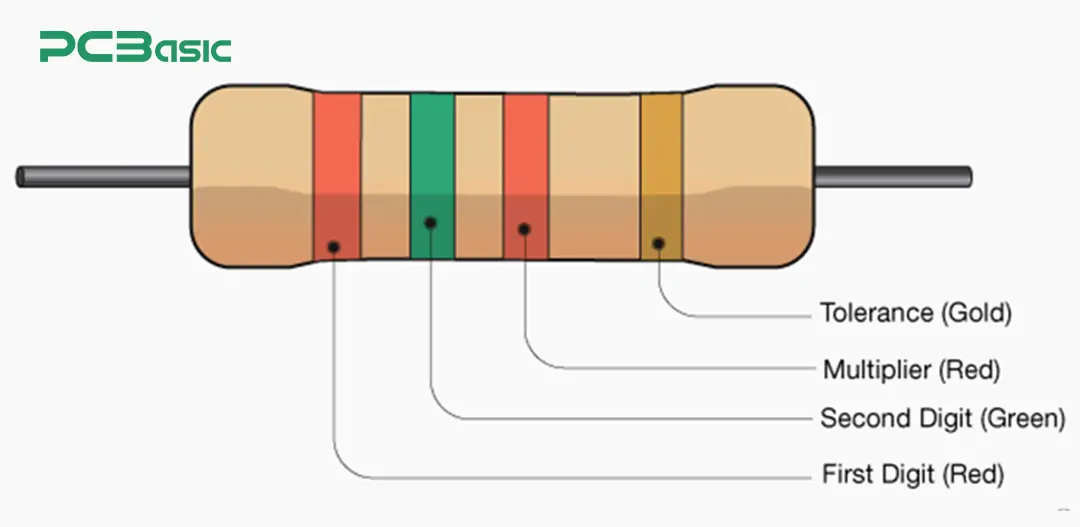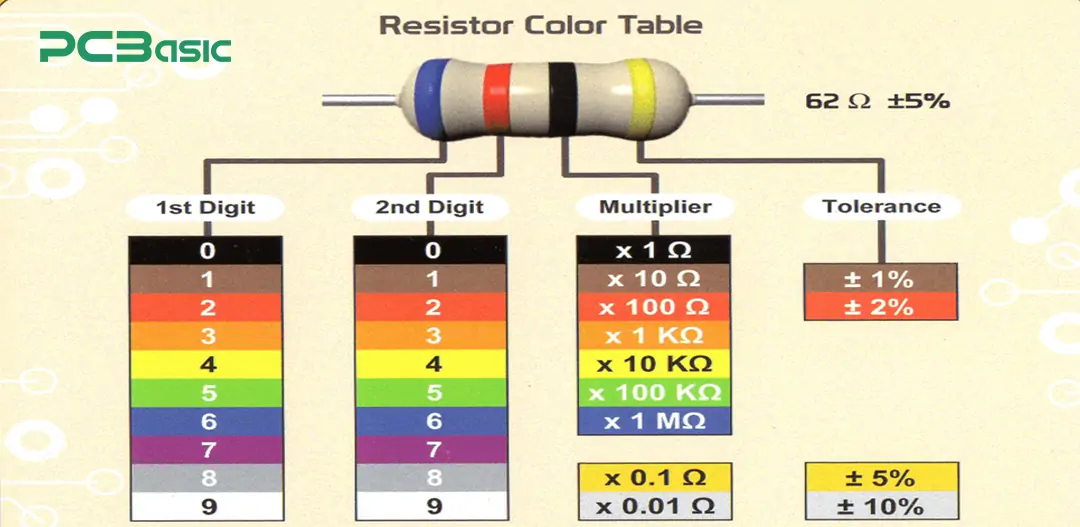

Global high-mix volume high-speed PCBA manufacturer
9:00 -18:00, Mon. - Fri. (GMT+8)
9:00 -12:00, Sat. (GMT+8)
(Except Chinese public holidays)


Global high-mix volume high-speed PCBA manufacturer
9:00 -18:00, Mon. - Fri. (GMT+8)
9:00 -12:00, Sat. (GMT+8)
(Except Chinese public holidays)
HomePage > Blog > Knowledge Base > 220 Ohm Resistor Color Code: A Complete Guide
So, are you getting started with electronics? You might be working on a project. Maybe you are fixing something, or just curious about those tiny colorful parts on a circuit board. Resistors are absolutely everywhere. Knowing their value is super important. But how do you figure out if that little piece is the 220 ohm resistor you need? That's why the resistor color code exists.
In simple words, it's a way colors tell you the resistor's value. Think of it as a special language for electronic parts. You might see a resistor with colored bands. Once you know the code, those bands give you key information.
Learning this code is a necessary basic step. You will see it's not that complex. This point is important. For example, the wrong resistor value can damage your circuit. Do not panic, though! The reason is that many people learn this code. You can learn it too. So in the following post, you will learn the code for a very common value: 220 ohms.

First, let's clarify and understand what a resistor does. To construct your concept, consider it as a small barrier for electricity. It resists the flow of current. The amount of resistance is measured in "ohms." We use the Greek letter Omega (Ω) for ohms. A resistor's ohm value tells you how much resistance it provides. A higher value means more resistance. A lower value means less resistance.
A 220 ohm resistor gives 220 units of resistance. It's a really standard value. It belongs to a set of common component values. Engineers know it's a common part. Using standard values helps make manufacturing simpler. It also helps keep costs down for companies that make PCBs and PCBAs. You will see 220 ohm resistors used in countless electronic items. Their commonality makes them easy to find and replace.
Why is it useful that 220 ohms is a common value? Because you will encounter it very often! You see 220 ohm resistors doing many basic jobs in circuits.
They are frequently used to limit the current going through components. A great example is protecting a small LED (Light Emitting Diode). If you connect an LED straight to power without a resistor, too much current can flow. This will likely burn out the LED. A 220 ohm resistor is often just the right size. It limits the current to a safe level for a standard LED. It acts like a safety valve.
They can also help in timing circuits. They are used as pull-up or pull-down resistors in digital circuits. Sometimes, they are part of filter circuits. Because they are common and reliable, they are a popular choice for many basic designs. Using them is standard practice when building prototypes. Benchmarking different circuit ideas often uses these reliable, standard parts. They provide a known level of resistance that designers can count on.
Okay, how do you read the value from those colored bands? This is where the resistor color code is essential. Printing the number "220 Ω" on a tiny resistor body is difficult to read. So, manufacturers use colored bands instead.

The number of bands and their meaning can change. Most resistors have 4 or 5 bands.
Each color stands for a number, a way to multiply, or a tolerance percentage.
1. Bands 1 and 2: These give you the first two numbers of the resistor's value.
2. Band 3: This is the multiplier band. It tells you how many zeros to add after the first two numbers. Or it tells you what factor to multiply by.
3. Band 4: This band shows the tolerance. This means how much the actual resistance might deviate from the value the bands state. For example, a 5% tolerance means the resistor's real value could be up to 5% higher or lower than 220 ohms.
So the basic point is, you read the colors. You start from one end. You use a standard chart to know what each color means in its position.
 About PCBasic
About PCBasic
Time is money in your projects – and PCBasic gets it. PCBasic is a PCB assembly company that delivers fast, flawless results every time. Our comprehensive PCB assembly services include expert engineering support at every step, ensuring top quality in every board. As a leading PCB assembly manufacturer, we provide a one-stop solution that streamlines your supply chain. Partner with our advanced PCB prototype factory for quick turnarounds and superior results you can trust.
So, how to read a 220-ohm resistor using the 4-band code? For instance, the value we want is 220 Ω.
1. The first number is 2. Look at the standard color code chart. The color for '2' is Red.
2. The second number is 2. Again, the color for '2' is Red.
3. The multiplier should be 22 into 220. You need to multiply 22 by 10. This adds one zero. The chart shows the color for a multiplier of 101. This color is Brown.
4. The fourth band is usually the tolerance. Common tolerances are 5% Gold and 10% 5. Silver. Let's assume it's a typical 5% resistor. The color for 5% tolerance is Gold.
So, the 4 band color code for a 220 ohm resistor with 5% tolerance is Red, Red, Brown, Gold.
Here is a quick look at how the colors match the value:
|
Band |
Color |
Meaning for 220 Ohm |
|
1st Digit |
Red |
2 |
|
2nd Digit |
Red |
2 |
|
Multiplier |
Brown |
x 10¹ (x 10) |
|
Tolerance |
Gold |
± 5% |
Knowing the color meanings is one step. How do you read the bands on the actual tiny component?
Position the Resistor
Look closely at the colored bands. Often, one band is slightly farther away from the others. This space is typically between the multiplier band (the third one) and the tolerance band (the fourth one). You should start reading from the end, where the bands are closer together. The tolerance band, often Gold or Silver, is usually a good clue to find the last band. It's usually on its own or further away.
Find the First Band
Read the color of the band closest to the starting end. For a 220 ohm resistor, this band should be Red. This gives you your first digit, which is 2.
Find the Second Band
Read the color of the next band. For 220 ohms, this should also be Red. This is your second digit, which is 2. So far, you have the number 22.
Find the Third Band
Read the color of the third band. For 220 ohms, this should be Brown. This color tells you what to multiply your first two digits (22) by. Brown means multiply by 10 (101). So, 22×10=220.
Find the Fourth Band
Read the color of the last band. For a common 220 ohm resistor, this band is likely Gold. Gold means the resistor has a ± 5% tolerance. This means the actual resistance could be between 209 ohms and 231 ohms.
Simultaneously, as you practice reading different resistors, you'll start to notice things. Common patterns will become familiar.
It's definitely obvious that practicing helps you get faster and more accurate. Don't try to rush when you start. Have patience. If you are ever unsure, just check the chart again or even use a multimeter to measure the value if possible. You can say it is the most common fault for people learning to read the bands in the wrong direction. But do not panic if you do this; just flip the resistor around and try again from the other end.
To read the code on any standard resistor, you need the full standard chart. Here is the general chart used for 4-band resistors:
|
Color |
Digit (Bands 1 & 2) |
Multiplier (Band 3) |
Tolerance (Band 4) |
|
Black |
0 |
10⁰ (1) |
- |
|
Brown |
1 |
10¹ (10) |
± 1% |
|
Red |
2 |
10² (100) |
± 2% |
|
Orange |
3 |
10³ (1,000) |
- |
|
Yellow |
4 |
10⁴ (10,000) |
- |
|
Green |
5 |
10⁵ (100,000) |
± 0.5% |
|
Blue |
6 |
10⁶ (1,000,000) |
± 0.25% |
|
Violet |
7 |
10⁷ (10,000,000) |
± 0.1% |
|
Gray |
8 |
10⁸ (100,000,000) |
± 0.05% |
|
White |
9 |
10⁹ (1,000,000,000) |
- |
|
Gold |
- |
10⁻¹ (0.1) |
± 5% |
|
Silver |
- |
10⁻² (0.01) |
± 10% |
|
None |
- |
- |
± 20% |

Use this chart as your guide. For our 220 ohm example (Red-Red-Brown-Gold), you find Red for the first digit (2). Then Red for the second digit (2). Brown is the multiplier (101, or 10). Gold is the tolerance (±5%). Put it together: 2 then 2, multiplied by 10. 22×10=220 ohms with 5% tolerance. This point is noticeable – how colors turn into numbers you need!
You will see many websites offer resistor color code calculators. These are helpful tools.
So, the basic point is that reading the color code on a resistor like the 220 ohm (Red-Red-Brown-Gold) is key. It tells you its value and tolerance. This skill is vital for electronics. Notice things like band spacing. Stay focused on using the chart correctly. Everything counts when building circuits. Get this right, and you're on your way!

Assembly Enquiry
Instant Quote
Phone contact

+86-755-27218592
In addition, we've prepared a Help Center. We recommend checking it before reaching out, as your question and its answer may already be clearly explained there.
Wechat Support

In addition, we've prepared a Help Center. We recommend checking it before reaching out, as your question and its answer may already be clearly explained there.
WhatsApp Support

In addition, we've prepared a Help Center. We recommend checking it before reaching out, as your question and its answer may already be clearly explained there.
